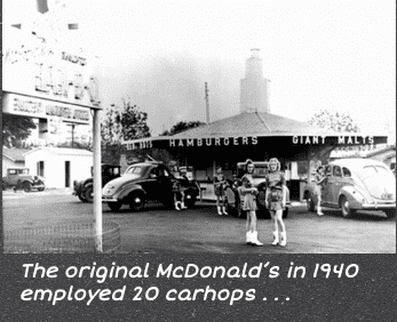
opened their first restaurant in San Bernardino CA (population 100,000) after getting a loan for $5000 from a major bank without collateral. The McDonald brothers wanted $7500, but the bank manager, against the wishes of the bank's board of directors, acted on a hunch for $5000. The restaurant was a drive-in, and it was an immediate hit, soon making a profit of $40k/year. Most customers were teen boys and young families; the McDonald brothers wanted to discourage the first group and encourage the second.
Originally, customers waited 20 minutes, and the brothers wanted to quicken the pace, without carhops. The Macdonalds understood that people were far more mobile and lived farther from work than ever before; more-and-more Americans seemed to be in a perpetual rush, and they wanted to eat quickly. So the McDonalds looked for any weaknesses that delayed service, and the first to go were the carhops.
To their surprise, the McDonalds discovered that their menu was far too large, and when they checked their receipts, they found that 80% of their business was hamburgers. That data meant that the brothers could get rid of the labor-intensive barbeque items, and that they could largely mechanize the process of making hamburgers. The McDonalds just wanted to maximize their profits, and it wasn't until years later that they realized that they had been at the forefront of a new US phenomenon . . . people wanted quality cheap food fast.
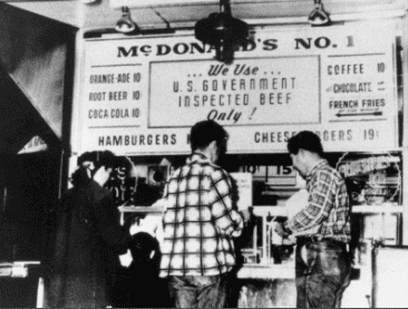
Also, the McDonalds chose the condiments, not the consumer: ketchup, mustard, onions, and two pickles. The brothers found a machine to uniformly create hamburger patties by posing as candy makers, finding a peppermint patty press that was perfect for their needs. Under the new system, if a customer wanted something different than what was offered, they faced a delay in service. The McDonalds also figured out they could keep their hamburgers hot with infrared lights. The whole process was based on speed, lower prices, and making money on volume ("McDonald's Famous Hamburgers (Buy 'em by the bag): 15 cents).
To their surprise, business at first fell off, but when they added milkshakes and french fries, their phenomenal succes began in earnest. By 1950, the teen thugs were elsewhere, replaced by working class families that, thanks to the low prices, could afford to take their families out to eat.
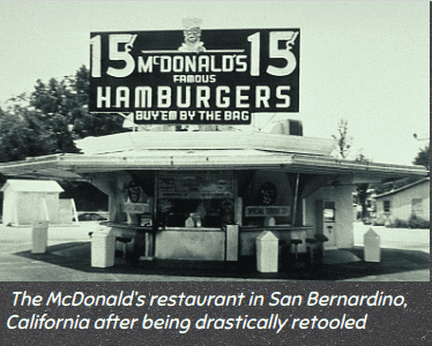
Ed Toman was the McDonald's Charlie Taylor, and in his San Bernardino shop, Toman helped create a stainless steel Lazy Susan for hamburger preparation (12 patties), a stronger steel spatula, and a condiment pump that dispensed the perfect amount. In the kitchen were 3 hamburger cooks, 2 milkshake guys, 2 french fry guys, 2 hamburger wrappers, and 3 men at the counter. Slack time was the opportunity to get ahead of the next rush.
By 1951, gross receipts were 40% higher at $277k, and by the mid-1950s, the McDonalds were sharing profits of $100k/year, a dazzling figure when one considers that what they were selling cost 15 cents. The McDonalds were uncommonly generous in sharing their expertise and knowledge with others. The brothers also knew they would have to franchise their operation, and in 1952 the McDonalds reluctantly sold their first franchise rights. The brothers were content with their lives, and really didn't want the responsibilities that franchising and expansion entailed . . . the McDonalds wanted an awesome-but-limited future.
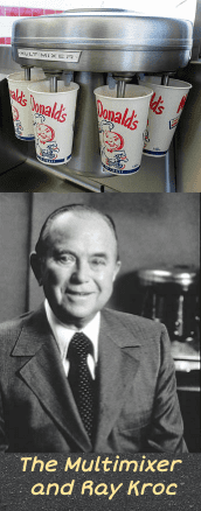
Kroc realized that the growth of the suburbs meant that he would sell less machines to city drugstores. By 1954, Kroc noticed that there was one restaurant in San Bernardino that still ordered Multi-Mixers; the McDonalds were making up to 50 milkshakes at the same time. In early-1954, Kroc went to the McDonalds restaurant and was instantly stunned . . . and instantly liked what he saw. Kroc noticed that the McDonalds (Toman) had cut the spindles so the milkshake cups could be bigger.
After talking to the McDonalds, Kroc saw that his future was in hamburgers, not milkshakes. The brothers were looking for someone to manage their franchising, which was then up to 9 other restaurants. Kroc took over the franchising for the McDonalds at the age of 52, and his already legendary work ethic grew even more. Kroc had been in countless restaurants, and he knew the McDonald brothers were on to something big.
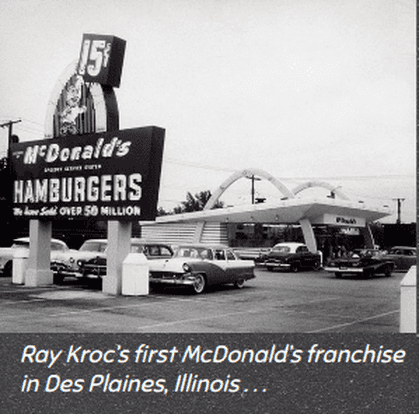
Kroc wanted to make all franchise operators conform to his culinary/economic vision, famously saying that the organization cannot trust the individual, the individual must trust the organization. Kroc found that the franchise operators in the Midwest, unlike California, acceded to his demands far more readily. In April 1955, Kroc opened a McDonalds in Des Plaines in suburban Chicago, which was the area Kroc was from.
Kroc was very hands-on with his very first store in Des Plaines, including personnel, often demanding certain grooming restrictions (e.g. no facial hair). Kroc also wanted Coca-Cola as the main beverage, and negotiated a sweet deal with the #1 regional Coca-Cola sales representative. By the second full year of the restaurant in Des Plaines, the store had a total volume of $200k in receipts. Second to Kroc's work ethic was his thrift, and waste drove Kroc crazy . . . it was a common site to see Kroc at the Des Plaines restaurant micromanaging his employees to minimize waste. Initially, Kroc made his money by taxing sales at the seemingly miniscule 1.9%. . . . eventually, Kroc would realize that much greater profits existed by taxing sales and becoming a de facto realtor for each new franchise.
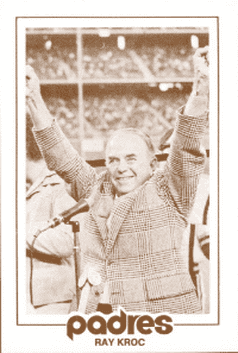
By then, the relationship between Kroc and the brothers had become strained. Kroc saw the brothers as nothing more than freeloaders, while the McDonalds wanted out of their deal with Kroc, but only on their terms. Kroc, in part because it was a smart business decision, and also because by then he was in an absolute fit over what he viewed as the brothers' intransigence, bought each brother out for $1 million each after taxes, $2.7 million total. It was a great deal of money, and Kroc was in debt from expansion, but he nonetheless put together a loan, sensing a bargain, especially looking at the long run.
The deal meant that Kroc owned the name McDonald's, and the brothers had to change the name of their beloved restaurant to "The Big M". Kroc, a very vindictive sort, opened a McDonald's franchise just one block away to steal their thunder . . . and their profits (that first restaurant had to close down). The real glory years for Kroc and McDonald's was just beginning. The only thing Kroc really wanted to do with his profits was to own a major league baseball team, which came true in 1974 when he purchased the San Diego Padres for $12 million.
(Below: the movie trailer for "The Founder", starring Michael Keaton & Nick Offerman)
 RSS Feed
RSS Feed
